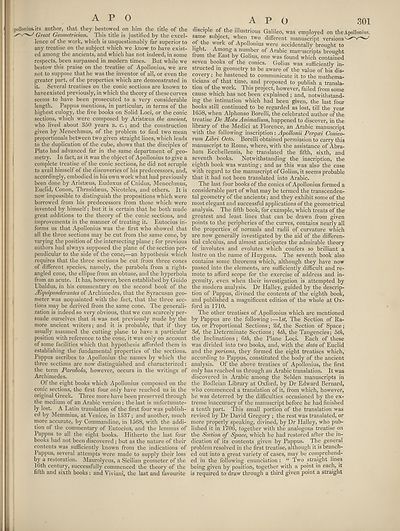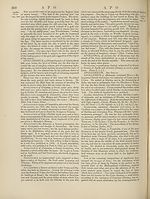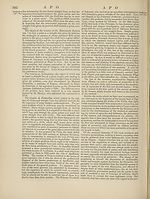Encyclopaedia Britannica > Volume 3, Anatomy-Astronomy
(309) Page 301
Download files
Complete book:
Individual page:
Thumbnail gallery: Grid view | List view

A P O
I ipollonius. its author, that they bestowed on him the title of the
Great Geometrician. This title is justified by the excel¬
lence of the work, which is unquestionably far superior to
any treatise on the subject which we know to have exist¬
ed among the ancients, and which has not indeed, in some
respects, been surpassed in modern times. But while we
bestow this praise on the treatise of Apollonius, we are
not to suppose that he was the inventor of all, or even the
greater part, of the properties which are demonstrated in
it. Several treatises on the conic sections are known to
have existed previously, in which the theory of these curves
seems to have been prosecuted to a very considerable
length. Pappus mentions, in particular, in terms of the
highest eulogy, the five books on Solid Loci, or the conic
sections, which were composed by Aristaeus the ancient,
who lived about 350 years b. c.; and the construction
given by Menechmus, of the problem to find two mean
proportionals between two given straight lines, which leads
to the duplication of the cube, shows that the disciples of
Plato had advanced far in the same department of geo¬
metry. In fact, as it was the object of Apollonius to give a
complete treatise of the conic sections, he did not scruple
to avail himself of the discoveries of his predecessors, and,
accordingly, embodied in his own work what had previously
been done by Aristaeus, Eudoxus of Cnidus, Menechmus,
Euclid, Conon, Thrasidaeus, Nicoteles, and others. It is
now impossible to distinguish the propositions which were
borrowed from his predecessors from those which were
invented by himself; but it is certain that he both made
great additions to the theory of the conic sections, and
improvements in the manner of treating it. Eutocius in¬
forms us that Apollonius was the first who showed that
all the three sections may be cut from the same cone, by
varying the position of the intersecting plane ; for previous
authors had always supposed the plane of the section per¬
pendicular to the side of the cone,—an hypothesis which
requires that the three sections be cut from three cones
of different species, namely, the parabola from a right-
angled cone, the ellipse from an obtuse, and the hyperbola
from an acute. It has, however, been established by Guido
Ubaldus, in his commentary on the second book of the
2Equiponderantes of Archimedes, that the Syracusan geo¬
meter was acquainted with the fact, that the three sec¬
tions may be derived from the same cone. The generali¬
zation is indeed so very obvious, that we can scarcely per¬
suade ourselves that it was not previously made by the
more ancient writers; and it is probable, that if they
usually assumed the cutting plane to have a particular
position with reference to the cone, it was only on account
of some facilities which that hypothesis afforded them in
establishing the fundamental properties of the sections.
Pappus ascribes to Apollonius the names by which the
three sections are now distinguished and characterized:
the term Parabola, however, occurs in the writings of
Archimedes.
Of the eight books which Apollonius composed on the
conic sections, the first four only have reached us in the
original Greek. Three more have been preserved through
the medium of an Arabic version ; the last is unfortunate¬
ly lost. A Latin translation of the first four was publish¬
ed by Memmius, at Venice, in 1537; and another, much
more accurate, by Commandine, in 1568, with the addi¬
tion of the commentary of Eutocius, and the lemmas of
Pappus to all the eight books. Hitherto the last four
books had not been discovered ; but as the nature of their
contents was sufficiently known from the indications of
Pappus, several attempts were made to supply their loss
by a restoration. Maurolycus, a Sicilian geometer of the
16th century, successfully commenced the theory of the
fifth and sixth books; and Viviani, the last and favoui'ite
A p o
disciple of the illustrious Galileo, was employed on theApoll
same subject, when two different manuscript versions
o the work of Apollonius were accidentally brought to
ig it. Among a number of Arabic manuscripts brought
from the East by Golius, one was found which contained
seven books of the conics. Golius was sufficiently in¬
structed in geometry to be aware of the value of his dis¬
covery ; he hastened to communicate it to the mathema¬
ticians of that time, and proposed to publish a transla¬
tion of the woik. This project, however, failed from some
cause which has not been explained; and, notwithstand¬
ing the intimation which had been given, the last four
books still continued to be regarded as lost, till the year
1658, when Alphonso Borelli, the celebrated author of the
treatise De Motu Animalium, happened to discover, in the
library of the Medici at Florence, an Arabic manuscript
with the following inscription: Apollonii Pergcei Conico-
rum Libri Octo. Borelli obtained permission to carry this
manuscript to Rome, where, with the assistance of Abra¬
ham Ecchellensis, he translated the fifth, sixth, and
seventh books. Notwithstanding the inscription, the
eighth book was wanting; and as this was also the case
with regard to the manuscript of Golius, it seems probable
that it had not been translated into Arabic.
The last four books of the conics of Apollonius formed a
considerable part of what may be termed the transcenden¬
tal geometry of the ancients ; and they exhibit some of the
most elegant and successful applications of the geometrical
analysis. The fifth book, for example, which treats of the
greatest and least lines that can be drawn from given
points to the peripheries of the curves, contains nearly all
the properties of normals and radii of curvature which
are now generally investigated by the aid of the differen¬
tial calculus, and almost anticipates the admirable theory
of involutes and evolutes which confers so brilliant a
lustre on the name of Huygens. The seventh book also
contains some theorems which, although they have now
passed into the elements, are sufficiently difficult and re¬
mote to afford scope for the exercise of address and in¬
genuity, even when their investigation is attempted by
the modern analysis. Dr Halley, guided by the descrip¬
tion of Pappus, divined the contents of the eighth book,
and published a magnificent edition of the whole at Ox¬
ford in 1710.
The other treatises of Apollonius which are mentioned
by Pappus are the following:—ls£, The Section of Ra¬
tio, or Proportional Sections; 2d, the Section of Space;
Sfi, the Determinate Sections; kth, the Tangencies; bth,
the Inclinations ; Qth, the Plane Loci. Each of these
was divided into two books, and, with the data of Euclid
and the porisms, they formed the eight treatises which,
according to Pappus, constituted the body of the ancient
analysis. Of the above treatises of Apollonius, the first
only has reached us through an Arabic translation. It was
discovered in Arabic among the Selden manuscripts in
the Bodleian Library at Oxford, by Dr Edward Bernard,
who commenced a translation of it, from which, however,
he was deterred by the difficulties occasioned by the ex¬
treme inaccuracy of the manuscript before he had finished
a tenth part. This small portion of the translation was
revised by Dr David Gregory ; the rest was translated, or
more properly speaking, divined, by Dr Halley, who pub¬
lished it in 1706, together with the analogous treatise on
the Section of Space, which he had restored after the in¬
dication of its contents given by Pappus. The general
problem resolved in the first treatise, although it is branch¬
ed out into a great variety of cases, may be comprehend¬
ed in the following enunciation : “ Two straight lines
being given by position, together with a point in each, it
is required to draw through a third given point a straight
I ipollonius. its author, that they bestowed on him the title of the
Great Geometrician. This title is justified by the excel¬
lence of the work, which is unquestionably far superior to
any treatise on the subject which we know to have exist¬
ed among the ancients, and which has not indeed, in some
respects, been surpassed in modern times. But while we
bestow this praise on the treatise of Apollonius, we are
not to suppose that he was the inventor of all, or even the
greater part, of the properties which are demonstrated in
it. Several treatises on the conic sections are known to
have existed previously, in which the theory of these curves
seems to have been prosecuted to a very considerable
length. Pappus mentions, in particular, in terms of the
highest eulogy, the five books on Solid Loci, or the conic
sections, which were composed by Aristaeus the ancient,
who lived about 350 years b. c.; and the construction
given by Menechmus, of the problem to find two mean
proportionals between two given straight lines, which leads
to the duplication of the cube, shows that the disciples of
Plato had advanced far in the same department of geo¬
metry. In fact, as it was the object of Apollonius to give a
complete treatise of the conic sections, he did not scruple
to avail himself of the discoveries of his predecessors, and,
accordingly, embodied in his own work what had previously
been done by Aristaeus, Eudoxus of Cnidus, Menechmus,
Euclid, Conon, Thrasidaeus, Nicoteles, and others. It is
now impossible to distinguish the propositions which were
borrowed from his predecessors from those which were
invented by himself; but it is certain that he both made
great additions to the theory of the conic sections, and
improvements in the manner of treating it. Eutocius in¬
forms us that Apollonius was the first who showed that
all the three sections may be cut from the same cone, by
varying the position of the intersecting plane ; for previous
authors had always supposed the plane of the section per¬
pendicular to the side of the cone,—an hypothesis which
requires that the three sections be cut from three cones
of different species, namely, the parabola from a right-
angled cone, the ellipse from an obtuse, and the hyperbola
from an acute. It has, however, been established by Guido
Ubaldus, in his commentary on the second book of the
2Equiponderantes of Archimedes, that the Syracusan geo¬
meter was acquainted with the fact, that the three sec¬
tions may be derived from the same cone. The generali¬
zation is indeed so very obvious, that we can scarcely per¬
suade ourselves that it was not previously made by the
more ancient writers; and it is probable, that if they
usually assumed the cutting plane to have a particular
position with reference to the cone, it was only on account
of some facilities which that hypothesis afforded them in
establishing the fundamental properties of the sections.
Pappus ascribes to Apollonius the names by which the
three sections are now distinguished and characterized:
the term Parabola, however, occurs in the writings of
Archimedes.
Of the eight books which Apollonius composed on the
conic sections, the first four only have reached us in the
original Greek. Three more have been preserved through
the medium of an Arabic version ; the last is unfortunate¬
ly lost. A Latin translation of the first four was publish¬
ed by Memmius, at Venice, in 1537; and another, much
more accurate, by Commandine, in 1568, with the addi¬
tion of the commentary of Eutocius, and the lemmas of
Pappus to all the eight books. Hitherto the last four
books had not been discovered ; but as the nature of their
contents was sufficiently known from the indications of
Pappus, several attempts were made to supply their loss
by a restoration. Maurolycus, a Sicilian geometer of the
16th century, successfully commenced the theory of the
fifth and sixth books; and Viviani, the last and favoui'ite
A p o
disciple of the illustrious Galileo, was employed on theApoll
same subject, when two different manuscript versions
o the work of Apollonius were accidentally brought to
ig it. Among a number of Arabic manuscripts brought
from the East by Golius, one was found which contained
seven books of the conics. Golius was sufficiently in¬
structed in geometry to be aware of the value of his dis¬
covery ; he hastened to communicate it to the mathema¬
ticians of that time, and proposed to publish a transla¬
tion of the woik. This project, however, failed from some
cause which has not been explained; and, notwithstand¬
ing the intimation which had been given, the last four
books still continued to be regarded as lost, till the year
1658, when Alphonso Borelli, the celebrated author of the
treatise De Motu Animalium, happened to discover, in the
library of the Medici at Florence, an Arabic manuscript
with the following inscription: Apollonii Pergcei Conico-
rum Libri Octo. Borelli obtained permission to carry this
manuscript to Rome, where, with the assistance of Abra¬
ham Ecchellensis, he translated the fifth, sixth, and
seventh books. Notwithstanding the inscription, the
eighth book was wanting; and as this was also the case
with regard to the manuscript of Golius, it seems probable
that it had not been translated into Arabic.
The last four books of the conics of Apollonius formed a
considerable part of what may be termed the transcenden¬
tal geometry of the ancients ; and they exhibit some of the
most elegant and successful applications of the geometrical
analysis. The fifth book, for example, which treats of the
greatest and least lines that can be drawn from given
points to the peripheries of the curves, contains nearly all
the properties of normals and radii of curvature which
are now generally investigated by the aid of the differen¬
tial calculus, and almost anticipates the admirable theory
of involutes and evolutes which confers so brilliant a
lustre on the name of Huygens. The seventh book also
contains some theorems which, although they have now
passed into the elements, are sufficiently difficult and re¬
mote to afford scope for the exercise of address and in¬
genuity, even when their investigation is attempted by
the modern analysis. Dr Halley, guided by the descrip¬
tion of Pappus, divined the contents of the eighth book,
and published a magnificent edition of the whole at Ox¬
ford in 1710.
The other treatises of Apollonius which are mentioned
by Pappus are the following:—ls£, The Section of Ra¬
tio, or Proportional Sections; 2d, the Section of Space;
Sfi, the Determinate Sections; kth, the Tangencies; bth,
the Inclinations ; Qth, the Plane Loci. Each of these
was divided into two books, and, with the data of Euclid
and the porisms, they formed the eight treatises which,
according to Pappus, constituted the body of the ancient
analysis. Of the above treatises of Apollonius, the first
only has reached us through an Arabic translation. It was
discovered in Arabic among the Selden manuscripts in
the Bodleian Library at Oxford, by Dr Edward Bernard,
who commenced a translation of it, from which, however,
he was deterred by the difficulties occasioned by the ex¬
treme inaccuracy of the manuscript before he had finished
a tenth part. This small portion of the translation was
revised by Dr David Gregory ; the rest was translated, or
more properly speaking, divined, by Dr Halley, who pub¬
lished it in 1706, together with the analogous treatise on
the Section of Space, which he had restored after the in¬
dication of its contents given by Pappus. The general
problem resolved in the first treatise, although it is branch¬
ed out into a great variety of cases, may be comprehend¬
ed in the following enunciation : “ Two straight lines
being given by position, together with a point in each, it
is required to draw through a third given point a straight
Set display mode to:
![]() Universal Viewer |
Universal Viewer | ![]() Mirador |
Large image | Transcription
Mirador |
Large image | Transcription
Images and transcriptions on this page, including medium image downloads, may be used under the Creative Commons Attribution 4.0 International Licence unless otherwise stated. ![]()
| Encyclopaedia Britannica > Encyclopaedia Britannica > Volume 3, Anatomy-Astronomy > (309) Page 301 |
|---|
| Permanent URL | https://digital.nls.uk/193761365 |
|---|
| Attribution and copyright: |
|
|---|---|
| Shelfmark | EB.16 |
|---|---|
| Description | Ten editions of 'Encyclopaedia Britannica', issued from 1768-1903, in 231 volumes. Originally issued in 100 weekly parts (3 volumes) between 1768 and 1771 by publishers: Colin Macfarquhar and Andrew Bell (Edinburgh); editor: William Smellie: engraver: Andrew Bell. Expanded editions in the 19th century featured more volumes and contributions from leading experts in their fields. Managed and published in Edinburgh up to the 9th edition (25 volumes, from 1875-1889); the 10th edition (1902-1903) re-issued the 9th edition, with 11 supplementary volumes. |
|---|---|
| Additional NLS resources: |
|

